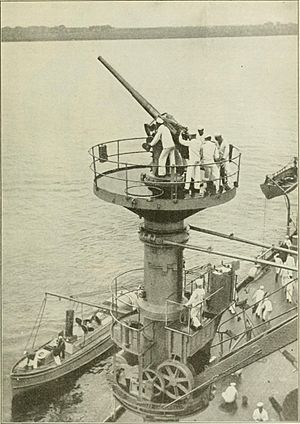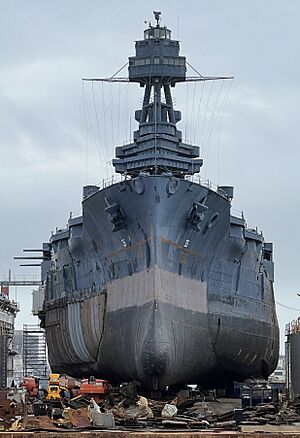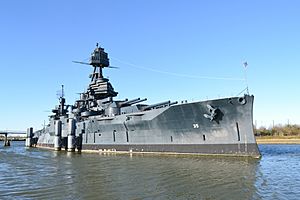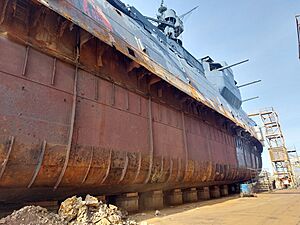USS Texas (BB-35) facts for kids
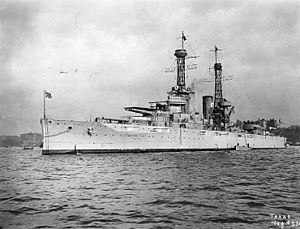
USS Texas (BB-35), off New York City c. 1919
|
|
Quick facts for kids History |
|
|---|---|
| Name | Texas |
| Namesake | State of Texas |
| Ordered | 24 June 1910 |
| Builder | Newport News Shipbuilding |
| Laid down | 17 April 1911 |
| Launched | 18 May 1912 |
| Commissioned | 12 March 1914 |
| Decommissioned | 21 April 1948 |
| Stricken | 30 April 1948 |
| Fate | Museum ship |
| General characteristics | |
| Class and type | New York-class battleship |
| Displacement | |
| Length | |
| Beam | 95 ft 2.5 in (29.020 m) |
| Draft |
|
| Installed power |
|
| Propulsion |
|
| Speed | 21 kn (39 km/h) |
| Range | 7,060 nmi (13,075 km; 8,125 mi) at 10 kn (19 km/h) |
| Complement | 1,042 officers and men |
| Armament |
|
| Armor |
|
| General characteristics (1945) | |
| Complement | 1810 officers and men |
| Sensors and processing systems |
|
| Armament |
|
| Armor | Turrets: 1.75 in (44 mm) added to turret tops |
| Aircraft carried | 2 × OS2U Kingfisher |
| Aviation facilities | 1 × catapult |
|
USS Texas
|
|
| Location | Galveston, Texas in drydock for repairs. |
| NRHP reference No. | 76002039 |
| Significant dates | |
| Added to NRHP | 8 December 1976 |
| Designated NHL | 8 December 1976 |
USS Texas (BB-35) is a famous museum ship located in Galveston, Texas. This former United States Navy battleship was launched on May 18, 1912, and officially joined the Navy on March 12, 1914. She is one of the very few remaining "dreadnought" battleships, which were powerful warships of their time.
Texas played an important role in both World War I and World War II. She was involved in the "Tampico Incident" in Mexico and later patrolled the North Sea during World War I. In World War II, she helped protect convoys across the Atlantic. She also shelled enemy positions during major landings in North Africa (Operation Torch) and Normandy (Operation Overlord). Later, she moved to the Pacific to support battles at Iwo Jima and Okinawa. Texas was the only Allied battleship to take part in all four of these important landings.
This battleship was also a testing ground for new technology. She was the first U.S. battleship to have anti-aircraft guns and to use special equipment to control her gunfire. Texas was also the first U.S. battleship to launch an airplane and one of the first U.S. Navy ships to get radar. She was even the first battleship in the world to be equipped with 14-inch guns.
After being taken out of service in 1948, Texas became the first U.S. battleship to be a permanent museum ship. She was given to the state of Texas and is now cared for by the Battleship Texas Foundation. In 1976, she was named a U.S. National Historic Landmark. Texas is one of only seven remaining ships, and the only large warship, to have served in both World Wars. She is currently undergoing major repairs in Galveston, with plans for a grand reopening in late 2025.
Building the Texas
The U.S. Congress approved the building of Texas on June 24, 1910. This was the second Navy ship named after the state. Newport News Shipbuilding won the contract to build her for $5,830,000.
The ship's bottom part, called the keel, was laid down on April 17, 1911, in Newport News, Virginia. She was officially launched on May 18, 1912. Miss Claudia Lyon, whose father was a Texas politician, sponsored the ship. Texas was put into service on March 12, 1914, with Captain Albert W. Grant in charge.
Texas's main weapons were ten 14-inch guns. These guns could fire heavy 1,400-pound shells up to 13 miles away. She also had twenty-one 5-inch guns for smaller targets. For underwater attacks, she carried four 21-inch torpedo tubes. These tubes held 12 torpedoes and 12 naval defense mines. Texas and her sister ship, New York, were unique because they stored their 14-inch ammunition nose-down in special cast-iron cups.
Ship's History
On March 24, 1914, Texas left Norfolk Navy Yard for New York City. She spent three weeks there getting special equipment installed to help control her gunfire.
Mexican Waters Duty
While Texas was in New York, President Woodrow Wilson sent several ships to Mexico. This was because of an event called the "Tampico Incident". Mexican soldiers had briefly held American sailors.
President Wilson wanted to pressure the Mexican government. On April 20, he ordered naval forces to land at Veracruz and take control of the customs house. This was a response to the incident.
Texas quickly sailed to Mexico on May 13, skipping her usual test trips. She joined the fleet off Veracruz on May 26. For over two months, she supported American forces on land. On August 8, she left Mexico and eventually returned to New York for repairs.
Later that year, Texas returned to the Mexican coast. She served as a station ship at Tuxpan and then visited Galveston, Texas. In Galveston, the ship received a special silver service from the state governor.
Texas left Mexico in December and returned to New York for more repairs. In May 1915, she helped rescue 230 passengers from a damaged passenger ship, the Ryndam. In 1916, Texas became the first U.S. battleship to have anti-aircraft guns. She also was the first to use special directors and rangefinders to control her gunfire.
World War I Service
When the U.S. entered World War I in April 1917, Texas was in Virginia. She trained gun crews for merchant ships. One of these crews, on the ship Mongolia, fired the first American shots of the war at a German submarine on April 19.
In September 1917, Texas ran aground on Block Island while heading for repairs. This caused damage to her hull and delayed her trip to join the British fleet. After repairs, she sailed to Scapa Flow, Scotland, in February 1918. There, she joined the British Grand Fleet.
Texas's job with the Grand Fleet was to escort convoys and help protect the North Sea. She often sailed to reinforce British ships on blockade duty. This was especially important when German warships threatened.
On April 24, 1918, Texas and the Grand Fleet sailed to intercept the German fleet. However, the German ships turned back before a battle could happen. For the rest of the war, Texas continued her patrols and convoy duties.
The war ended on November 11, 1918. On November 21, Texas joined the Grand Fleet to meet the surrendering German Fleet. Afterward, she sailed to England and then returned to the United States, arriving in New York on Christmas Day, 1918.
Between the World Wars
After World War I, Texas continued her duties with the Atlantic Fleet. On March 10, 1919, she made history by becoming the first American battleship to launch an airplane. A British-built Sopwith Camel flew off the ship in Cuba.
Later in 1919, Texas's captain, Nathan C. Twining, showed that airplanes could help spot where shells landed during gun practice. This made gunfire much more accurate. Because of this, the Navy decided to add floatplanes to all battleships and newer cruisers.
In May 1919, Texas helped the Navy's NC-4 flying boat become the first aircraft to cross the Atlantic. In July 1919, Texas moved to the Pacific Ocean, joining the new Pacific Fleet. She stayed there for over five years.
In 1924, Texas returned to the East Coast. She helped sink the unfinished battleship Washington to follow the Naval Arms Limitation Treaty. In July 1925, she went into the Norfolk Navy Yard for a big upgrade.
During this upgrade, her tall "cage masts" were replaced with stronger "tripod masts". Her old coal-fired boilers were replaced with new oil-fired ones. She also got "anti-torpedo bulges" on her sides to protect against torpedo attacks. Her anti-aircraft guns were increased, and her torpedo tubes were removed.
After her upgrade in 1926, Texas became the flagship of the United States Fleet. In 1927, she made another first by showing "talking pictures" for her crew's entertainment. In 1928, she carried President Calvin Coolidge to Cuba for a conference.
From 1931 to 1937, Texas was based in Los Angeles, California. She served as the flagship for the entire fleet and later for Battleship Division 1. In 1937, she returned to the East Coast to train sailors and Marines.
Also in 1937, more anti-aircraft guns were added. In 1938, Texas received the first shipborne radar designed for the U.S. Navy. By 1941, she had the advanced CXAM-1 radar.
World War II Service
Early Missions
When war started in Europe in September 1939, Texas began patrolling to keep the war away from the Americas. Later, she started escorting ships carrying supplies to the United Kingdom as part of the Lend-Lease program.
In February 1941, the U.S. 1st Marine Division was officially formed aboard Texas. On December 7, 1941, the day of the attack on Pearl Harbor, Texas was in Maine. She then returned to Newfoundland for watch duty.
In early 1942, she escorted a convoy to England and patrolled near Iceland. For the next six months, she continued escorting convoys to various places, including Panama and Sierra Leone. Her anti-aircraft weapons were greatly increased during this time, adding many 40mm and 20mm cannons.
Operation Torch: North Africa
On October 23, 1942, Texas began her first major combat mission. She joined the invasion force for Operation Torch, the attack on North Africa. Their goal was Port Lyautey in French Morocco.
On November 8, the warships arrived off the beaches. Texas broadcasted a message from General Dwight D. Eisenhower, asking the French not to fight the Allied landings. Texas fired her guns later that day, hitting a French ammunition dump. She fired again on November 10 before a ceasefire on November 11.
Texas was one of only three U.S. battleships to take part in Operation Torch. Young news reporter Walter Cronkite was aboard Texas during this operation. He was flown off the ship early to report the news, which helped launch his career as a war correspondent.
Operation Overlord: D-Day
Throughout 1943, Texas escorted convoys across the Atlantic. This continued into 1944 until April 22, when she stayed in Scotland to train for the invasion of Normandy.
Practice and Preparation
For twelve days, Texas practiced firing her 14-inch guns with British battleships. Airplanes helped spot the targets. On April 29, Texas moved to Belfast Lough, Northern Ireland. Here, her observation planes were removed, and their pilots joined a special squadron, VOS-7. These pilots flew British Spitfire fighter planes to spot targets on D-Day.
General Eisenhower visited Texas on May 19 to speak to the crew. On May 31, the ship was sealed, and the crew learned about the upcoming invasion. Texas was chosen to lead the bombardment force for the western part of Omaha Beach. She would support the U.S. 29th Infantry Division and Rangers at Pointe du Hoc.
On June 3, 1944, Texas sailed from Belfast Lough for Normandy. The invasion fleet had to turn back briefly due to bad weather but then continued. They navigated through German minefields, and no ships were lost.
D-Day Action
At 3:00 AM on June 6, 1944, Texas arrived at her firing position off Pointe du Hoc. She was part of a large fleet of 702 ships. The bombardment began at 5:50 AM, with Texas firing at six 15-cm guns on Pointe du Hoc. She fired 255 14-inch shells in 34 minutes, her longest continuous firing during the war. Her 5-inch guns targeted areas leading to the beach exits.
As the day went on, the attack on Omaha Beach faced strong German resistance. To help the soldiers, Texas moved very close to the shore, only 3,000 yards away. She fired her main guns at a low angle to clear the exit roads and hit hidden sniper and machine gun nests.
On June 7, Texas sent supplies and ammunition to the isolated Rangers at Pointe du Hoc. The returning boats brought 35 wounded Rangers to Texas for treatment. They also brought 27 prisoners of war. Later, Texas shelled German towns and a mortar battery. That night, German planes attacked, but Texas's anti-aircraft guns missed them.
By June 15, the troops had moved too far inland for Texas's guns to reach. For her last mission, the crew even flooded a part of the ship to tilt it, giving the guns enough elevation. Texas left Normandy for England on June 18.
Battle of Cherbourg
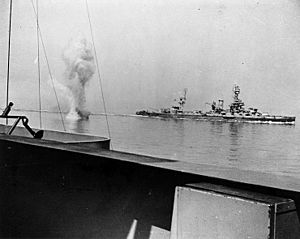
On June 25, Texas and other ships attacked the port of Cherbourg. Their goal was to destroy the German forts and batteries while the U.S. Army attacked the city from land. Texas and Arkansas were ordered to target Battery Hamburg, a large battery with four 24-cm guns.
At 12:08 PM, Arkansas fired first. The German gunners waited until Texas and Arkansas were closer before firing back. At 1:16 PM, a German shell hit Texas's conning tower. It damaged the bridge, wounded seven sailors, and killed the helmsman, Christen Christensen.
Another unexploded 24-cm shell crashed through the ship's bow. It landed in a warrant officer's room but did not explode. This shell is now displayed on the ship. Despite the damage, Texas continued firing her 14-inch guns. She scored a direct hit that destroyed one of the German guns. After a three-hour battle, Texas was ordered to retreat at 3:01 PM.
Operation Dragoon: Southern France
After repairs in England, Texas prepared for the invasion of southern France. On July 16, she sailed to the Mediterranean Sea. She arrived off Saint-Tropez on August 14.
On August 15, Texas began her pre-landing bombardment at 4:44 AM. She fired at a battery of five 15-cm guns. Visibility was very poor, so Texas used her radar to navigate and aim her guns.
The expected strong German resistance did not happen, and the landing forces moved inland quickly. Since her gunfire was no longer needed, Texas left France on August 17. After a stop in Sicily, she sailed for New York, arriving on September 14, 1944.
Iwo Jima and Okinawa
In New York, Texas had her main gun barrels replaced. She received nine of her original gun barrels that had served on her from 1914 to 1923. After a short training trip, she sailed for the Pacific in November.
She arrived off Iwo Jima on February 16, 1945, three days before the landings. For three days, she heavily shelled Japanese defenses. After the Marines landed on February 19, Texas provided gunfire support for them until February 21.
Texas left Iwo Jima on March 7 and went to prepare for the invasion of Okinawa. She arrived in the Ryukyu Islands on March 26. For six days, she fired her main guns to prepare the way for the Army and Marine landings on April 1.
Each evening, Texas moved away from Okinawa, returning each morning to continue firing. Japanese air units, including kamikaze planes, attacked the bombardment group. Texas was not damaged and claimed one kamikaze kill and three assists.
Due to the constant threat of kamikazes, Texas was at general quarters (battle stations) for over 50 days straight at Okinawa. This meant the crew was always ready for battle. She fired a huge amount of ammunition during the Okinawa campaign. On May 14, she left Okinawa for the Philippines.
End of the War
On May 17, Texas arrived at Leyte in the Philippines. She stayed there until Japan surrendered on August 15. She returned to Okinawa in late August and then sailed for the United States on September 23. She carried troops returning home as part of Operation Magic Carpet.
Texas delivered her passengers to San Pedro, California, on October 15. She then made two more trips between California and Hawaii, bringing more American troops home. On January 21, 1946, Texas sailed to Norfolk to prepare to be taken out of service. On June 18, she was officially placed in reserve in Baltimore, Maryland.
A Museum Ship
Becoming a Memorial
On April 17, 1947, the Battleship Texas Commission was created to care for the ship. They raised $225,000 to tow her from Baltimore to Texas. On March 17, 1948, Texas began her journey to her new home near the San Jacinto Monument in San Jacinto State Park. She arrived on April 20 and was given to the State of Texas the next day.
Texas was officially taken out of service on April 21, 1948, and became the first permanent battleship museum in the U.S. She was also made the flagship of the ceremonial Texas Navy.
Over the years, the ship faced problems due to lack of funding. Water leaked into the ship, and steel began to rust. In 1968, her wooden deck was so rotten that it was replaced with concrete. However, the concrete also cracked, causing more leaks. In the 1970s, charitable groups helped fund repairs.
In 1975, Texas was named a National Historic Mechanical Engineering Landmark. In 1976, she became a National Historic Landmark.
Under State Care
By 1983, the Texas Parks and Wildlife Department (TPWD) took over control of the ship. They hired experts to check the ship's condition. The survey showed that the hull had many holes, and water was getting in everywhere. The experts said the ship needed to go into a dry dock for major repairs. After five years of fundraising, $15 million was collected.
1988–1990 Dry Dock Repairs
On December 13, 1988, Texas was carefully moved from her berth by six tugboats. She traveled 56 miles to Todd Shipyards in Galveston. During the trip, she started taking on water, and pumps had to work continuously.
Texas entered the dry dock that night. For 14 months, workers sandblasted the ship and replaced tons of rusted metal. They replaced weakened beams and rusted deck plates. The concrete deck was removed, and a new pinewood deck was installed. More than 375,000 pounds of steel were replaced, and 40,000 rivets were sealed.
In February 1990, Texas moved to another facility for more repairs. Here, the wooden deck was finished, and four of her 40mm anti-aircraft guns were installed. On July 26, she returned to San Jacinto, where the remaining six 40mm guns were added.
The ship was repainted in the dark blue "Measure 21" scheme she wore in the Pacific during World War II. This matched her new anti-aircraft weapons. The repairs were finished, and Texas reopened to the public on September 8, 1990.
Future Plans: Dry Berth
In 2004, the TPWD planned to put Texas in a permanent dry berth to protect her from the water. In 2007, Texas voters approved $25 million for this project. The Battleship Texas Foundation (BTF) also raised $4 million in private funds.
However, the dry berth project faced delays. By 2019, funds were still needed for construction. Instead, efforts focused on repairing the ship. On May 28, 2019, it was announced that Texas would undergo $35 million in repairs and then move to a new location along the Texas coast. The ship closed to the public to prepare for this restoration.
Leaks and Repairs
Texas has had several leaks over the years. In June 2010, a broken pump caused a leak that made the ship sink a few feet. Crews had to pump out 105,000 gallons of water.
In June 2012, about 30 new leaks were found, closing the ship for three weeks. In June 2017, a 6-by-8-inch hole caused the ship to tilt six degrees. Emergency repairs were made, and thousands of gallons of water were pumped out.
2022–2025 Dry Dock Period
On August 31, 2022, Texas was towed to a floating dry dock in Galveston for major repairs. The journey took four tugboats and lasted about four hours. The dry dock itself was a salvaged and repaired structure.
Once repairs are complete, the Battleship Texas Foundation plans to berth the ship permanently in Galveston. The Texas government provided $35 million for repairs, with an additional $25 million in 2023. The U.S. government also gave a matching $35 million grant. These funds are only for repairing the battleship, not for cosmetic work or new museum buildings.
In November 2023, the Port of Galveston approved Galveston as the new home for Texas. She left dry dock on March 5, 2024. She is still receiving more repairs while afloat, focusing on her upper parts, smaller guns, and inside spaces.
On March 4, 2025, the Galveston Wharves Board voted to offer Pier 15 as a permanent home for the USS Texas. As of August 2025, Texas is still being repaired, but offers tours on Sundays. The Battleship Texas Foundation hopes to have a grand reopening in late 2025.
Remembering Texas
Texas was the first and is the oldest of the eight U.S. battleships that are now permanent floating museums. She turned 110 years old on March 12, 2024, making her one of the oldest surviving modern naval ships.
Amateur radio operators use the callsign NA5DV from Texas during special events like Museum Ship Weekend and Pearl Harbor Day. In 1995, the Texas Legislature named the battleship Texas the official "State Ship of Texas."
Texas in Media

Texas has appeared in several movies. Her first brief appearance was in the 1937 film Boy of the Streets. Scenes for the 1966 film The Sand Pebbles were shot on board but later removed.
For the 2001 film Pearl Harbor, Texas was chosen because she is the only surviving American battleship built before 1941. Her look was very similar to other battleships from that time. Many scenes were filmed on her decks and inside. The interior scenes for the aircraft carrier Hornet were also filmed inside Texas.
Actual footage of Texas was used in the 2006 films Flags of Our Fathers and Letters from Iwo Jima. Close-up shots of actors using her smaller guns were also filmed. Computer effects were added to show her main turrets turning and firing.
Texas also appears as a multiplayer map in the video games Call of Duty: Vanguard and Call of Duty: WWII. Players fight on the ship's deck during World War II. However, the game's layout of the ship is not exactly like the real USS Texas.
See also
 In Spanish: USS Texas (BB-35) para niños
In Spanish: USS Texas (BB-35) para niños
- U.S. Navy museums (and other battleship museums)
- Japanese battleship Mikasa, the only surviving pre-dreadnought battleship





